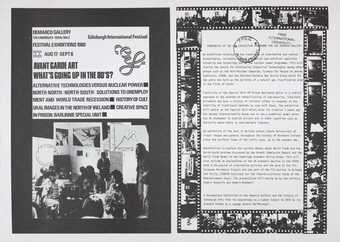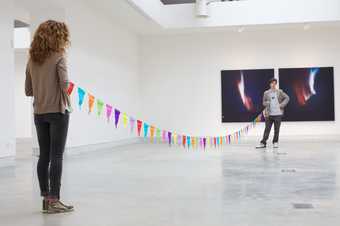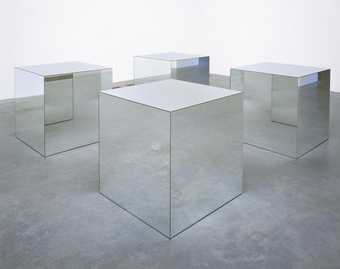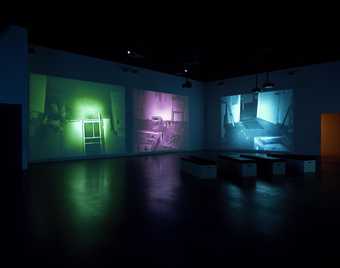Join members of Tate’s Time-Based Media Conservation team, curators and researchers from Tate’s Reshaping the Collectible research team as they attempt to conserve and re-stage avant-garde artist Tony Conrad's Ten Years Alive On The Infinite Plain, a performance artwork comprising of 16mm film, projectors, and several musical instruments.
Tony Conrad is no longer alive, and the artwork didn’t have a written score for future performances. The Reshaping the Collectible project team brought together past performers of the artwork and a new set of performers to produce a new score, as well as working together to re-perform 10 Years Alive On The Infinite Plain at Tate Liverpool as part of the annual LightNight festival in May 2019.
Support for the creation of this film was provided by a grant from The Andrew W. Mellon Foundation.
[Andrea Lissoni]: He’s unframeable – that’s the great point. I mean, you cannot frame someone who didn’t want to be framed. Tony Conrad is an unclassifiable artist. He was a ground-breaking filmmaker and musician. He was a great pedagogue. Beyond this, he was a committed cultural activist.
[Rhys Chatham]: One of the very first concerts that I produced at The Kitchen was with Tony Conrad – to play the world premiere of what has become Ten Years On the Infinite Plain.
[AL]: It’s an expanded cinema performance composed of four different projections of black and white stripes that slowly move to the centre and then form a square.
[Pip Laurenson]: Alongside those projections, we have three instruments. So there’s the long string drone which is an instrument that Tony Conrad invented, we have a bass guitar, and we have a violin, and they basically are responding to the soundtrack of Tony Conrad playing, and when he was alive he would have played the violin himself.
[AL]: The hope is an experience based on length: it engages with our feeling of memory, and engages with the idea of what does it mean to see a shape changing and becoming literally alive? Ten Years Alive on an Infinite Plain embodies the contradictory history of the museum, already in its title. Conserving doesn’t mean looking back ever, it always means looking ahead. And keeping a work alive in the way that 10 Years Alive On An Infinite Plain requires is the most challenging but also exciting experience for a conservator and a curator in a museum.
[PL]: The work is really held by a network of people, but of course when a work comes into a museum collection we’re thinking far in the future where that network won’t be there to support a work. How do we plan to think about a longer legacy for a work like this?
[Hélia Marçal]: What we want to do is to create the conditions for new possibilities to emerge that are still within the spirit of Tony Conrad and within the spirit of his work. And the transmitters are a key part of that process, as well as the new generation of performers.
[AL]: Tony is no longer there but he was aware of the fact that he wouldn’t have been around, so he made his best to create the condition for the work to be transmitted. He didn’t give any specific instruction because this was actually his attitude, he didn’t want to teach vertically, he didn’t want to be authoritarian… The beauty of 10 Years Alive on An Infinite Plain is against structures, against forms of power and it’s wonderful to celebrate Tony Conrad in that way.
[George Maund]: The instrument I’ll be performing on is known as the long string drone. And it consists of 1 metre 50 5 feet of aluminium, about 2cm thick and at one end of the machine head is for tuning, the other pickups, and then 2 wooden bridges to maintain the balance of the flat wound strings. The bass guitar strings are tuned to C sharp, and they’re flat wound so that when you attack and apply the glissando, you don’t get like a scraping sound, you get a smooth percussive movement upward.
[Tony Conrad]: So this instrument was meant to be played just with a basis of one note, and it could be played with a metal bar like this to make… this is just… It could also be played with a bow, and here’s the tray for the bow here, so… (music plays)
[RC]: I remember using a cylinder like this to do the work. My role in the project at the Tate is to transmit the music to another person so that anyone can play.
The way I was doing it was going down, and then bringing the slide up to the mark that you have there. But it's basically done by ear, right? We have the drone going down and we're hearing a C sharp drone, so it's (music plays)
I don't know if that's a C sharp but...
[GM]: Maybe not, no.
[RC]: But in the context of the music, we just tuned it with our ear. The music isn't notated and had to be taught in oral fashion. Tony told me what to play, and with a bit of back and forth between the two of us, we arrived at something we were both happy with.
[GM]: So that’s the, that’s the kinda the big payoff, maybe at some point in the second half, if we’re allowed to
[RC]: Yes, I noticed when you did that yesterday, I considered that.. Wow, George is innovating, and I quite liked it, and I was not a little jealous thinking why didn’t I think of that?
[PL]: It’s so interesting talking to people who’ve performed it before because so much of what they’re talking about is a type of embodied knowledge, and they talk body memory, they talk about the memory of performing the piece coming back
[Angharad Davies]: I have a document of the first performance, and the Leeds performance. "Right hand started hurting halfway through, felt like stopping but didn't want to in case I couldn't pick up the violin. Played like mad, everything hurt and I shook at the end." So these are kind of physical things. The reality of what 90 minutes does to your body.
[Catherine Landen]: Yes, I think that’s.. something like that, those kind of um, approaching it from like a physical point of view, you know, as you watch it your mind kind of plays tricks on you. So just to have that written down is really helpful.
[PL]: The value of being able to access this group of people has been really extraordinary in terms of that ability to learn from them, to have them really show us and pass on their knowledge of this work and these instruments and what Tony Conrad was trying to convey in this piece.
[Emily Lansley]: I think I need like, really literal guidance, but then after the big conversation yesterday where we were chatting about everything for so long. I thought that was really helpful, just like hearing about him as a person.
[Dominic Lash]: Right
[EL]: Hearing his violin louder, trying to sort of like think about it a bit differently to maybe being so rigid
[DL]: I mean I’ve played it, I realised I hadn’t remembered just listening back I was playing it faster than you.
[EL]: Right.
[DL]: So it has a different feeling.
[EL]: So it has a different feeling altogether then, doesn’t it, I suppose?
[DL]: But it’s a pulse, I suppose everyone has their…
[EL]: … has their momentum.
[DL]: Yeah.
[PL]: The real challenge of this work is to understand what we need to stay the same, what’s structurally part of the work and where the variability, where the change can be. And we really don’t want this work to live in the museum as a kind of fixed, locked down thing, so how do we allow a work like this to continue to have its life?
[AL]: Where the artwork begins and ends is one of the great question that we have to engage with when working in a museum. Is it about props? Instruments? Apparatuses? Or is it about the pure experience? I would say in the case of 10 Years On An Infinite Plain, it is both. What will be continuing in the next days and weeks and months perhaps, is the beginning of a ripple effect that we hope will be lasting forever and allowing the work to be alive on an infinite plain





